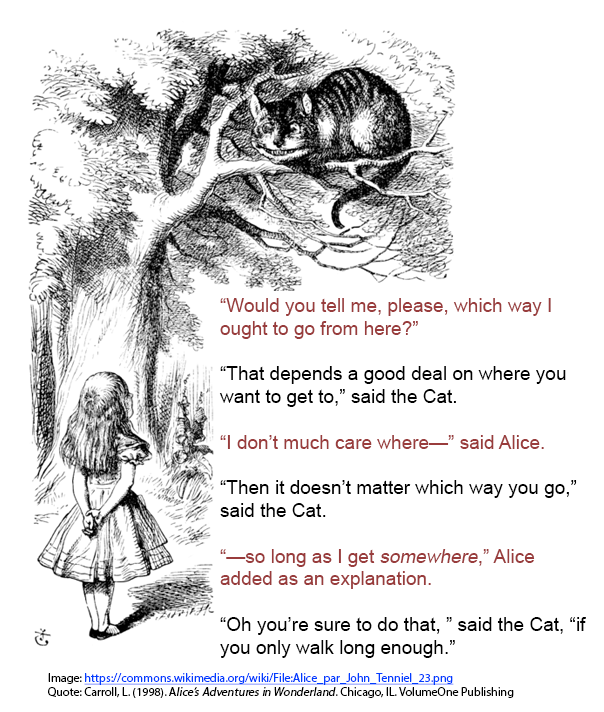
In a consultation, I was recently asked why it is important that students know the course and module learning objectives. I’d like to take this opportunity to share why we should not only strive to write complete and measurable objectives but work to share them with students so they can take more responsibility in their own learning.
First, I’d like you to consider this exchange between Alice and the Cheshire Cat in Lewis Carroll’s Alice in Wonderland:

How do our students, like Alice, know what path to choose or whether they have arrived if they don’t have a destination in mind? In education (at any level), learning objectives become that destination and offer the following three benefits:
- Objectives communicate specifically what students should be able to do.
For example, students in an entry-level business technology course can have a clear idea of what skills they will gain by successfully completing the course with these course-level objectives:
By the end of the course, with reasonable effort, you will be able to:
- Critique how organizations utilize and improve computer and communications technology
- Apply technology to support business planning, operations, marketing, strategy, and decision making
- Analyze how businesses use the internet, social media, and technology to connect with customers and employees, market and deliver their products, and create a competitive advantage
- They tell students what is important.
While everything taught within a class is important (otherwise we wouldn’t be teaching it, right?), objectives quickly signal to students a hierarchy of importance and help students strategize where they should focus their time while studying the course materials.
- They guide students as they work through the course and assess their learning process.
Lastly, clear, measurable learning objectives provide a guide for students when reviewing materials and preparing for assessment. Module-level objectives are most beneficial and powerful if they are measurable and clearly support the course-level objectives.
| Original objective |
Specific, measurable and actionable objective |
| Learn how businesses use social media to reach new customers or clients |
List three social media techniques businesses can use to reach new customers or clients |
| Be able to create a social media campaign |
Design, develop, and implement a three-week social media campaign that: identifies a target audience, obtains market research, and includes two multi-platform accessible posts |
| Understand what role ethics plays in how businesses utilize technology |
Identify situations and questions in which ethics plays a role in business decisions. |
So why share learning objectives with students? In 2016, Mary-Ann Winkelmes et al. found that sharing learning objectives with students helped them become self-regulated learners and in turn, increased student learning in both foundational knowledge (short-term retention) and higher-order cognitive processes (application and transfer). For example, undergraduate students reported that having clear learning objectives identified and communicated to them helped them narrow their focus on important concepts and skills, organize their notes, track their learning, and improve their overall study practices (Simon, 2009). Because learning outcomes help students make strategic decisions, “students also feel an increased sense of control or ownership” over their learning (Cornell, n.d.).
The research of Winkelmes et al. (2016) also indicated that sharing learning outcomes prior to learning also increased student motivation and engagement. That makes sense, right? If our students understand what is expected of their learning, they are more likely to feel that they can be successful in meeting those expectations. Winkelmes’ research also found this to be particularly true for first-generation, low-income, and underrepresented students.
Just like in Alice’s exchange with the Cat, simply sharing the objectives with students is only part of the road map to the destination. The full power of objectives is unlocked when they become part of an instructor’s teaching practice. This can be easily achieved by making them part of lecture slides or encouraging students to review them and set learning goals or self-checks. Unlike your favorite Crockpot meal, you can’t just set it and forget it by having them listed in the syllabus or on a Canvas page and never revisiting them. The somewhere we want our students to get to is self-directed learning, and making objectives part of the conversation is an important step in making students become responsible for not only hearing the information you’ve crafted for your course but truly learning it.
This is the first in a mini series regarding the benefits for learning objectives for students, instructors, and community stakeholders.
References
Cornell University Center for Teaching Innovation. Setting Learning Outcomes. https://teaching.cornell.edu/teaching-resources/designing-your-course/s…
Simon, B., & Taylor, J. (2009). What is the value of course-specific learning goals? Journal of College Science Teaching, 39, 52-57. http://www.cwsei.ubc.ca/SEI_research/files/LifeSci/Simon_Taylor_ValueOf…
Winkelmes, M.-A., Bernacki, M., Butler, J., Zochowski, M., Golanics, J., & Weavil, K. H. (2016). A teaching intervention that increases underserved college students’ success. Peer Review, 18. http://www.aacu.org/peerreview/2016/winter-spring/Winkelmes
-Bryant “Laz” Lazenby, Instructional Designer
Laz is a lifelong learner and technology lover who joined Missouri Online as an Instructional Designer in July 2021. He is a Level 2 Google Certified Educator, has over 9 years of teaching experience in secondary and post-secondary education, and is currently working on obtaining a doctoral degree in educational leadership from Lindenwood University. He was born and raised on a farm that has been in his family for over a century located northwest of Sedalia, Mo., where he lives today. When he isn’t in front of his computer, he can generally be found reading or attending local painting classes.
